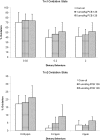Dietary selenium as a modulator of PCB 126-induced hepatotoxicity in male Sprague-Dawley rats
- PMID: 21865291
- PMCID: PMC3196656
- DOI: 10.1093/toxsci/kfr215
Dietary selenium as a modulator of PCB 126-induced hepatotoxicity in male Sprague-Dawley rats
Abstract
Homeostasis of selenium (Se), a critical antioxidant incorporated into amino acids and enzymes, is disrupted by exposure to aryl hydrocarbon receptor (AhR) agonists. Here we examined the importance of dietary Se in preventing the toxicity of the most toxic polychlorinated biphenyl congener, 3,3',4,4',5-pentachlorobiphenyl (PCB 126), a potent AhR agonist. Male Sprague-Dawley rats were fed a modified AIN-93 diet with differing dietary Se levels (0.02, 0.2, and 2 ppm). Following 3 weeks of acclimatization, rats from each dietary group were given a single ip injection of corn oil (vehicle), 0.2, 1, or 5 μmol/kg body weight PCB 126, followed 2 weeks later by euthanasia. PCB exposure caused dose-dependent increases in liver weight and at the highest PCB 126 dose decreases in whole body weight gains. Hepatic cytochrome P-450 (CYP1A1) activity was significantly increased even at the lowest dose of PCB 126, indicating potent AhR activation. PCB exposure diminished hepatic Se levels in a dose-dependent manner, and this was accompanied by diminished Se-dependent glutathione peroxidase activity. Both these effects were partially mitigated by Se supplementation. Conversely, thioredoxin (Trx) reductase activity and Trx oxidation state, although significantly diminished in the lowest dietary Se groups, were not affected by PCB exposure. In addition, PCB 126-induced changes in hepatic copper, iron, manganese, and zinc were observed. These results demonstrate that supplemental dietary Se was not able to completely prevent the toxicity caused by PCB 126 but was able to increase moderately the levels of several key antioxidants, thereby maintaining them roughly at normal levels.
Figures




Similar articles
-
Dietary antioxidants (selenium and N-acetylcysteine) modulate paraoxonase 1 (PON1) in PCB 126-exposed rats.Environ Sci Pollut Res Int. 2014 May;21(10):6384-99. doi: 10.1007/s11356-013-1690-1. Epub 2013 May 4. Environ Sci Pollut Res Int. 2014. PMID: 23644946 Free PMC article.
-
Does dietary copper supplementation enhance or diminish PCB126 toxicity in the rodent liver?Chem Res Toxicol. 2013 May 20;26(5):634-44. doi: 10.1021/tx400049s. Epub 2013 Apr 15. Chem Res Toxicol. 2013. PMID: 23527585 Free PMC article.
-
NTP toxicology and carcinogenesis studies of 3,3',4,4',5-pentachlorobiphenyl (PCB 126) (CAS No. 57465-28-8) in female Harlan Sprague-Dawley rats (Gavage Studies).Natl Toxicol Program Tech Rep Ser. 2006 Jan;(520):4-246. Natl Toxicol Program Tech Rep Ser. 2006. PMID: 16628245
-
NTP technical report on the toxicology and carcinogenesis studies of 2,2',4,4',5,5'-hexachlorobiphenyl (PCB 153) (CAS No. 35065-27-1) in female Harlan Sprague-Dawley rats (Gavage studies).Natl Toxicol Program Tech Rep Ser. 2006 May;(529):4-168. Natl Toxicol Program Tech Rep Ser. 2006. PMID: 16835634
-
N-acetylcysteine (NAC) diminishes the severity of PCB 126-induced fatty liver in male rodents.Toxicology. 2012 Dec 8;302(1):25-33. doi: 10.1016/j.tox.2012.07.007. Epub 2012 Jul 21. Toxicology. 2012. PMID: 22824115 Free PMC article.
Cited by
-
Identification of lipidomic markers of chronic 3,3',4,4',5-pentachlorobiphenyl (PCB 126) exposure in the male rat liver.Toxicology. 2017 Sep 1;390:124-134. doi: 10.1016/j.tox.2017.09.005. Epub 2017 Sep 7. Toxicology. 2017. PMID: 28890136 Free PMC article.
-
Glutathione transferase pi class 2 (GSTp2) protects against the cardiac deformities caused by exposure to PAHs but not PCB-126 in zebrafish embryos.Comp Biochem Physiol C Toxicol Pharmacol. 2012 May;155(4):573-9. doi: 10.1016/j.cbpc.2012.01.007. Epub 2012 Jan 16. Comp Biochem Physiol C Toxicol Pharmacol. 2012. PMID: 22269188 Free PMC article.
-
Sustained expression of CYPs and DNA adduct accumulation with continuous exposure to PCB126 and PCB153 through a new delivery method: Polymeric implants.Toxicol Rep. 2014 Jan 1;1:820-833. doi: 10.1016/j.toxrep.2014.09.010. Toxicol Rep. 2014. PMID: 25530946 Free PMC article.
-
PCB126 induced toxic actions on liver energy metabolism is mediated by AhR in rats.Toxicology. 2022 Jan 30;466:153054. doi: 10.1016/j.tox.2021.153054. Epub 2021 Nov 27. Toxicology. 2022. PMID: 34848246 Free PMC article.
-
Metallothionein's role in PCB126 induced hepatotoxicity and hepatic micronutrient disruption.Toxicol Rep. 2016;3:21-28. doi: 10.1016/j.toxrep.2015.12.001. Toxicol Rep. 2016. PMID: 26770886 Free PMC article.
References
-
- Alcock RE, Behnisch PA, Jones KC, Hagenmaier H. Dioxin-like PCBs in the environment-human exposure and the significance of sources. Chemosphere. 1998;37:1457–1472. - PubMed
-
- Anderson ME. Determination of glutathione and glutathione disulfide in biological samples. Methods Enzymol. 1985;113:548–555. - PubMed
-
- Bandiera S, Safe S, Okey AB. Binding of polychlorinated biphenyls classified as either phenobarbitone-, 3-methylcholanthrene- or mixed-type inducers to cytosolic Ah receptor. Chem. Biol. Interact. 1982;39:259–277. - PubMed
-
- Banni M, Messaoudi I, Said L, El Heni J, Kerkeni A, Said K. Metallothionein gene expression in liver of rats exposed to cadmium and supplemented with zinc and selenium. Arch. Environ. Contam. Toxicol. 2010;59:513–519. - PubMed
-
- Bardia A, Tleyjeh IM, Cerhan JR, Sood AK, Limburg PJ, Erwin PJ, Montori VM. Efficacy of antioxidant supplementation in reducing primary cancer incidence and mortality: systematic review and meta-analysis. Mayo Clin. Proc. 2008;83:23–34. - PubMed
Publication types
MeSH terms
Substances
Grants and funding
LinkOut - more resources
Full Text Sources
Medical

